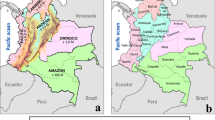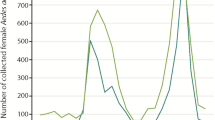Abstract
Malaria is preventable and curable but critical disease caused by parasites that are transmitted to people through the bites of female Anopheles mosquitoes. There were an estimated 228 million cases of malaria globally and its mortality remained at 405,000 in 2018. There are many models that have been developed but the aim of this paper is to analyse the potential impact of multiple current interventions in communities with limited resources. The authors in their previous work, developed a population-based model of malaria transmission dynamics to investigate the effectiveness of five different interventions. This model captured both the human and the mosquito compartments and considered 5 control interventions. Namely it was: educational campaigns to mobilise people for diagnostic test and treatment and to sleep under bed nets; treatment through mass drug administration; indoor residual spraying with insecticide to reduce malaria transmission; insecticide treated net to reduce morbidity; and regular destruction of mosquito breeding sites to reduce the number of new mosquito and bites/contact at dusks and dawn. In the present work we carried out basic mathematical analysis of the model, simulate the different scenarios developed and optimise the control interventions with optimal control. The potential of the control interventions to reduce transmission within 120 days was observed. The numerical experiments showed that the optimal strategy to effectively control malaria was through the combinations of controls in the models. The developed malaria model predicted the reduction, control and/or elimination of malaria threats through incorporating multiple control interventions. Therefore, multiple control measures should be adopted for malaria but in areas of limited resources, we can make use of strategy E and others in places where there are more resources.














Similar content being viewed by others
References
Agusto, F.B., Lenhart, S.: Optimal control of the spread of malaria superinfectivity. J. Biol. Syst. 21(4), 1–26 (2013)
Agusto, F.B., Marcus, N., Okosun, K.O.: Application of optimal control to the epidemiology of malaria. Electr. J. Differ. Equ. 81(1), 1–22 (2012)
Alifrangis, M., Lemnge, M.M., Moon, R., Theisen, M., Bygbjerg, I., Ridley, R.G., Jakobsen, P.H.: IgG reactivities against recombinant Rhoptry-Associated Protein-1 (rRAP-1) are associated with mixed Plasmodium infections and protection against disease in Tanzanian children. Parasitology 119, 337–342 (1999)
Arez, A.P., Pinto, J., Palsson, K., Snounou, G., Jaenson, T.G., Do Rosario, V.: Transmission of mixed Plasmodium species and Plasmodium falciparum genotypes. Am. J. Trop. Med. Hyg. 68, 161–168 (2003)
Bakare, E.A.: On the Qualitative behaviour of a human-mosquito model for Malaria with multiple vector control strategies. Int. J. Ecol. Econ. Stat. 36(2), 96–113 (2015)
Bakare, E.A., Onasanya, B.O., Hoskova-Mayerova, S., Olubosede, O.: Analysis of Control Interventions against Malaria in communities with Limited Resources, accepted, Analele St. Univ. Ovidius Constanta Vol. xx(x), 2021, 0-19(2021)
Bekesiene, S., Hoskova-Mayerova, S.: Decision tree-based classification model for identification of effective leadership indicators in the Lithuania army forces. J. Math. Fund. Sci 50(2), 121–141 (2018). https://doi.org/10.5614/j.math.fund.sci.2018.50.2.2
Bokil, V.A., Allen, L.J.S., Jeger, M.J., Lenhart, S.: Optimal control of a vectored plant disease model for a crop with continuous replanting. J. Biol. Dyn. 14(1), 90–115 (2019). https://doi.org/10.1080/17513758.2019.1622808
Cai, L., Li, X., Tuncer, N., Martcheva, M., Lashari, A.A.: Optimal control of a malaria model with asymptomatic class and superinfection. Math. Biosci. 4, 14 (2017)
Castillo, C.: Optimal control of an epidemic through educational campaigns. Electr. J. Differ. Equ. 125, 1–11 (2006)
Chitnis, N., Cushing, J.M., Hyman, J.M.: Bifurcation analysis of a mathematical model for malaria transmission. SIAM J. Appl. Math. 67(1), 24–45 (2006)
Collins, O.C., Duffy, K.J.: Optimal control of foliar disease dynamics for multiple maize varieties. Acta Agric. Scand. 68(5), 412–423 (2017). https://doi.org/10.1080/17513758.2017.1337245
Covell, G.: Relationship between malaria paresitaemia and symptoms of the disease: a review of the literature. Bull. World Health Organ. 22, 605–619 (1960)
Depinay, J.M.O., Mbogo, C.M., Killeen, G., Knols, B., Beier, J., Carlson, J., Dushoff, J., Billingsley, P., Mwambi, H., Githure, J., Toure, A.M., McKenzie, F.E.: A simulation model of African anopheles ecology and population dynamics for the analysis of malaria transmission. Malaria J. 3, 29 (2004)
Ferguson, J., O’Leary, N., Maturo, F., Yusuf, S., O’Donnell, M.: Graphical comparisons of relative disease burden across multiple risk factors. BMC Med. Res. Methodol. (2019). https://doi.org/10.1186/s12874-019-0827-4
Gabriel, O., Joseph, K.K., John, M.M.: Cost effectiveness analysis of optimal malaria control strategies in Kenya. Mathematics 4, 14 (2016)
Gu, W., Killen, G.F., Mbogo, C.M., Regens, J.L., Githure, J.I., Beier, J.C.: An individual-based model of Plasmodium falciparum malaria transmission on the coast of Kenya. Trans. R. Soc. Trop. Med. Hyg. 97, 43–50 (2003)
Koella, J.C.: On the use of mathematical models of malaria transmission. Acta Trop. 49, 1–25 (1991)
Kudlak, A., Urban, R., Hoskova-Mayerova, S.: Determination of the Financial Minimum in a Municipal Budget to Deal with Crisis Situations. Soft. Comput. 24(12), 8607–8616 (2020). https://doi.org/10.1007/s00500-019-04527-w
Maturo, F.: Unsupervised classification of ecological communities ranked according to their biodiversity patterns via a functional principal component decomposition of Hill’s numbers integral functions. Ecol. Ind. 90, 305–315 (2018). https://doi.org/10.1016/j.ecolind.2018.03.013
Molineaux, L., Gramiccia, G.: The Garki Project. World Health Organization, Geneva (1980)
Mwasa, A., Tchuenche, J.M.: Mathematical analysis of a cholera model with public health interventions. Biosystems 105, 190–200 (2011)
Ngwa, G.A., Shu, W.S.: A mathematical model for the endemic malaria with variable human and mosquito populations. Math. Comput. Model. pp. 747–763 (2000)
Nuno, M., Feng, Z., Martcheva, M., Castillo-Chavez, C.: Dynamics of two-strain influenza with isolation and partial cross-immunity. SIAM J. Appl. Math. 65(3), 964–982 (2005)
Ogunmiloro, O.M.: Stability analysis and optimal control strategies of direct and indirect transmission dynamics of conjunctivitis. J. Math. Meth. Appl. Sci. (2020). https://doi.org/10.1002/mma.6756
Okosun, K.O.: Mathematical epidemiology of Malaria disease transmission and its optimal control analysis. Ph.D. thesis, University of the Western Cape, South Africa, (2010)
Okosun, K.O. Mathematical epidemiology of Malaria disease transmission and its optimal control analysis. Ph.D. thesis, University of the Western Cape, South Africa (2010)
Olaniyi, S., Okosun, K.O., Adesanya, S.O., Lebelo, R.S.: Modelling malaria dynamics with partial immunity and protected travellers: optimal control and cost-effectiveness analysis. J. Biol. Dyn. 14(1), 90–115 (2020). https://doi.org/10.1080/17513758.2020.1722265
Rafikov, M., Bevilacqua, L., Wyse, A.P.P.: Optimal control strategy of malaria vector using genetically modified mosquitoes. J. Theor. Biol. 258, 418–425 (2009)
Sepulveda, L.S., Vasilieva, O.: Optimal control approach to dengue reductionand prevention in Cali, Colombia. Math. Meth. Appl. Sci. (2016). https://doi.org/10.1002/mma.3932
Snow, R.W., Omumbo, J.: Malaria. In Jamison D.T. et al. (ed.) Diseases and Mortality in Sub-Saharan Africa, The World Bank, pp. 195–213 (2006)
Tilahun, G.T., Makinde, O.D., Malonza, D.: Modelling and optimal control of pneumonia disease with cost-effective strategies. J. Biol. Dyn. 11(52), 400–426 (2017). https://doi.org/10.1080/17513758.2017.1337245
Tušer, I. Bekesiene, S., Navrátil, J.: Emergency management and internal audit of emergency preparedness of pre-hospital emergency care. Qual. Quant. (2020). https://doi.org/10.1007/s11135-020-01039-w
Urban, R., Hoskova-Mayerova, S.: Threat life cycle and its dynamics. Deturope 9(2), 93–109 (2017)
WHO; Malaria, fact sheets, http://www.who.int/inf-fs/en/fact094.html (2020)
Yang, H.M.: Malaria transmission model for different levels of acquired immunity and temperature-dependent parameters (vector). J. Publ. Health 34, (2000)
Acknowledgements
Second author thanks The Police Academy of the Czech Republic in Prague for its support.
Author information
Authors and Affiliations
Corresponding author
Additional information
Publisher's Note
Springer Nature remains neutral with regard to jurisdictional claims in published maps and institutional affiliations.
Rights and permissions
About this article
Cite this article
Bakare, E.A., Hoskova-Mayerova, S. Numerical treatment of optimal control theory applied to malaria transmission dynamic model. Qual Quant 57 (Suppl 3), 409–431 (2023). https://doi.org/10.1007/s11135-020-01092-5
Accepted:
Published:
Issue Date:
DOI: https://doi.org/10.1007/s11135-020-01092-5
Keywords
- Optimal control
- Computational simulations
- Disease Free Equilibrium
- Pontryagin’s Maximum Principle
- Stability theory




